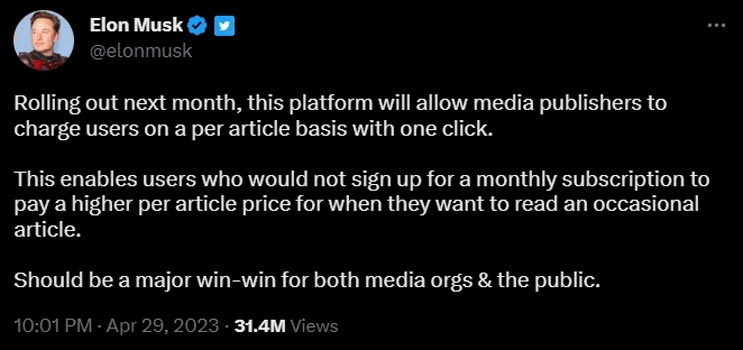Twitter will launch its pay-per-article service next month, allowing users to pay for individual articles instead of committing to a full subscription. On Saturday, Elon Musk, the CEO of Twitter, announced this move; he believes that this “one-click” service will be a significant win-win for both media organizations and the public. The service is expected to allow media companies to charge higher prices per article to readers who wouldn’t usually pay for a full subscription. However, Musk did not specify the percentage that Twitter would pocket from this service or the conditions that media publishers would need to abide by. This article will explore the implications of Twitter’s pay-per-article service and how it could revolutionize the media industry.

Implications of Twitter’s Pay-Per-Article Service
A New Revenue Stream for Media Organizations
With the rise of free news on the internet, media organizations have struggled to formulate subscription plans that can pay their operating costs. However, Twitter’s pay-per-article service could provide a new revenue stream for media organizations. By allowing readers to pay for individual articles, media companies can charge higher prices for their content, making it more profitable to produce high-quality journalism.

A Way to Attract New Readers
Twitter’s pay-per-article service could also attract new readers who may not have been willing to pay for a full subscription. By allowing readers to pay for individual articles, media companies can cater to a broader audience, including those interested in specific topics but not interested in subscribing to the entire publication.
A More Flexible Model for Readers
Twitter’s pay-per-article service offers readers a more flexible model for consuming news. Instead of committing to a full subscription, readers can choose which articles to read and pay for only those. This could be especially appealing to readers interested in specific topics but may not have the time to read every article in a publication.
The Musk Plan: Will It Succeed?
Elon Musk’s plan to introduce Twitter‘s pay-per-article service has raised questions about how this micro-payment approach will work when others have failed. Some experts believe that Twitter’s large user base and Musk’s star power could make the service successful. However, others are skeptical, citing the failure of other micro-payment models in the past.
FAQs
How will Twitter’s pay-per-article service work?
Twitter’s pay-per-article service will allow users to pay for individual articles instead of committing to a full subscription. Media organizations can charge higher prices per article to readers who wouldn’t usually pay for a full subscription.
When will Twitter’s pay-per-article service be available?
Elon Musk estimates that Twitter’s pay-per-article service will be available “next month.” However, as with all Musk timelines, it’s best to take this estimate as an absolute best-case scenario.
What percentage of the revenue will Twitter pocket?
Musk did not specify the percentage of revenue that Twitter will pocket from its pay-per-article service.
What is Twitter Pay-Per-Article, and how does it work?
Twitter Pay-Per-Article is a new micro-transaction service that allows users to pay for individual articles on social media rather than subscribing to a whole media company. Users can access the pieces with just one click, and media companies can charge a higher per-article price to readers who wouldn’t necessarily pay for a full subscription.
When will Twitter Pay-Per-Article be available to users?
Elon Musk announced that the service will be available starting “next month.” However, it’s best to take this timeline with a grain of salt, given Musk’s track record for setting ambitious deadlines.
How will media companies benefit from Twitter Pay-Per-Article?
Media companies can benefit from this service by charging a higher per-article price to readers who wouldn’t usually subscribe to their content. This could provide a new revenue stream for media companies struggling to make ends meet in the age of free online news.
Will Twitter be taking a percentage of the payment for each article?
Musk did not specify what percentage Twitter would take for itself from each payment. However, Twitter will likely cut the price to cover its operating costs.
What challenges will Twitter face in implementing this new service?
One challenge Twitter will face is ensuring readers trust the quality of the articles they’re paying for. Additionally, some media companies may be hesitant to participate in this program if they feel that Twitter is taking too large a cut of the payment for each article.
Wrap Up
Twitter’s announcement of a pay-per-article service has the potential to bring about a revolutionary change in the media industry. With this new service, readers would have access to a more flexible model where they can pick and choose the articles they want to read rather than subscribing to an entire publication. This could potentially attract more readers who are hesitant to subscribe to a journal because of the high cost. This new revenue stream for media organizations could help them sustain their business, especially when many traditional media outlets struggle to stay afloat.
While there are still questions about the logistics of the service, the announcement has already generated excitement and interest from both media organizations and the public. Overall, if executed well, Twitter’s pay-per-article service has the potential to benefit all parties involved, providing new revenue opportunities for media organizations while offering a more affordable and flexible model for readers.

Selva Ganesh is the Chief Editor of this Blog. He is a Computer Science Engineer, An experienced Android Developer, Professional Blogger with 8+ years in the field. He completed courses about Google News Initiative. He runs Android Infotech which offers Problem Solving Articles around the globe.



Leave a Reply